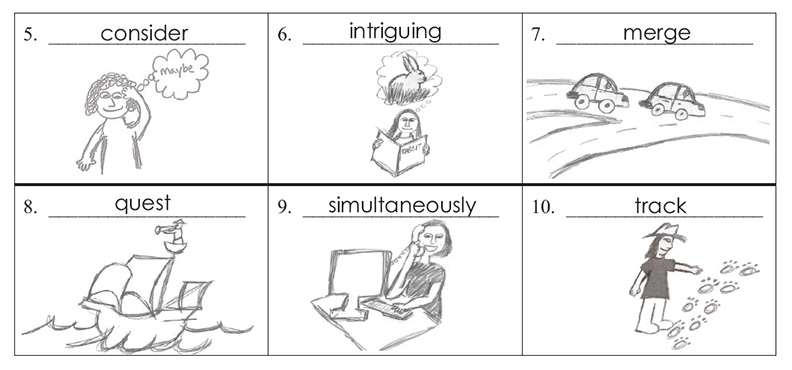In order to continue improving in reading comprehension, students need to continually expand their vocabularies. As much as teachers might like to explicitly teach them all the words they need to learn, this just isn’t realistic. Students need to learn strategies for figuring out new words on their own.
Last month, we shared with you several effective strategies for vocabulary instruction. These strategies include providing student-friendly definitions; teaching students to use context clues; taking the time to define words in context; teaching students to sketch new vocabulary words; teaching students to apply words to their own experiences; teaching students to analyze word parts; helping students make semantic maps; and helping students develop word consciousness.
In this post, we would like to elaborate on one strategy in particular: sketching vocabulary words. For many students, it is easier to remember a word’s meaning if they make a quick sketch that connects the word to something personally meaningful. Thinking about how to sketch the word and then taking the time to create the sketch helps the student solidify the meaning of the word and thus incorporate it into his or her general vocabulary.
For example, here are some sketches a student made for the vocabulary words “consider,” “intriguing,” “merge,” “quest,” “simultaneously,” and “track.” Notice how each sketch helps the student connect with the word’s meaning.

Each sketch is simple but meaningful. By looking at the sketch, the student who drew it will be able to quickly conjure the definition of the vocabulary word.
This vocabulary acquisition strategy is effective, fun for students, and easy for teachers to employ. To implement it, instruct a student to sketch his or her understanding of a new word you are explicitly teaching. The student should not spend much time making a detailed drawing—the sketch simply needs to make sense and help the student remember the meaning. To confirm understanding, the student should be able to describe the sketch and explain how it illustrates the word’s meaning.
Once students are comfortable with this strategy, encourage them to use it to remember the meanings of new words they encounter in the future. To work independently, they may use this strategy in conjunction with a dictionary or glossary. You may want to provide a template with a small space for each sketch, so students remember to make quick (rather than elaborate) sketches. This free template has spaces for sketching six target words, like in the example above.
Sketching vocabulary words is one of the vocabulary acquisition strategies featured in our popular Take Aim at Vocabulary program. This program, best for students in grades four and up, uses research-based vocabulary lessons to help students learn the meaning of high-utility words and develop lifelong vocabulary acquisition techniques. For more information about this program, watch the prerecorded Introduction to Take Aim! at Vocabulary webinar. Central Standard Time. This free webinar is perfect for teachers, specialists, and administrators interested in learning more about the research-based strategies that promote vocabulary growth and how the Take Aim program integrates them in an engaging way. If you wish to learn more but cannot attend the live session, we will make a recording of the webinar available afterwards. Check our webinars page for more information.
We are committed to helping students improve reading comprehension, and vocabulary plays a crucial role in that process. Please reach out with any questions or concerns related to vocabulary instruction or any other aspect of literacy development.
 Share your student’s success story—nominate him or her for our Star of the Month award. Win a Barnes & Noble gift card for the student and a Read Naturally gift certificate for your class!
Share your student’s success story—nominate him or her for our Star of the Month award. Win a Barnes & Noble gift card for the student and a Read Naturally gift certificate for your class!
Post a New Comment